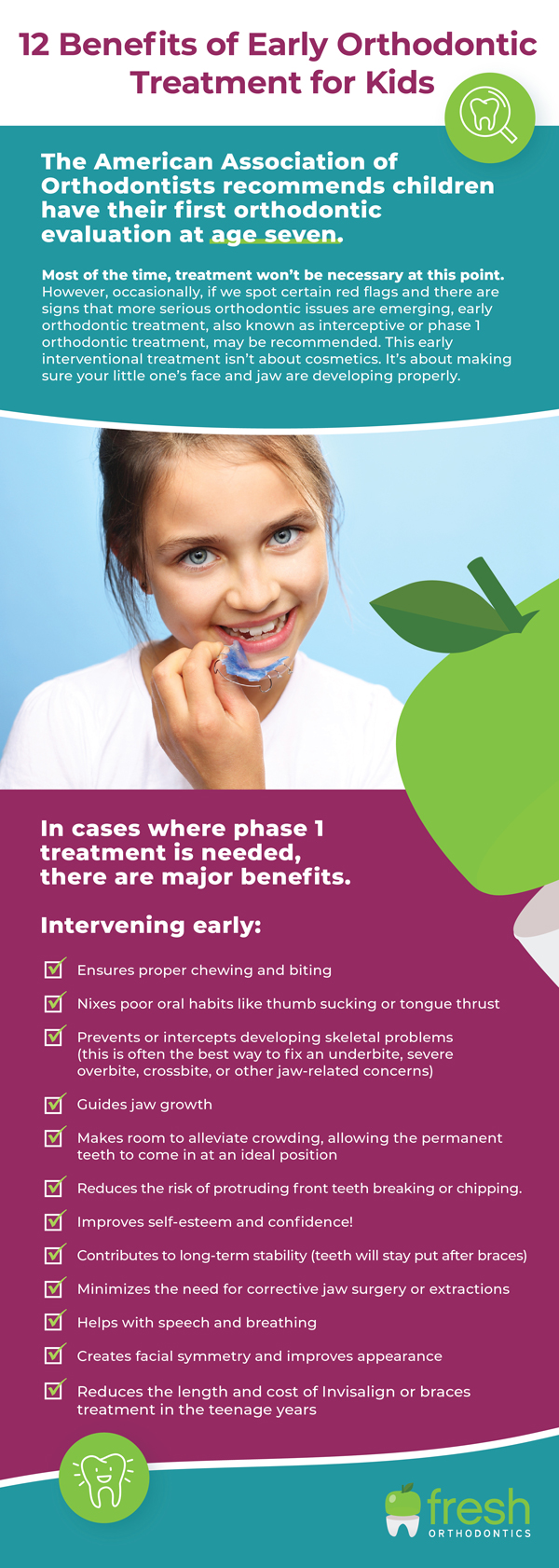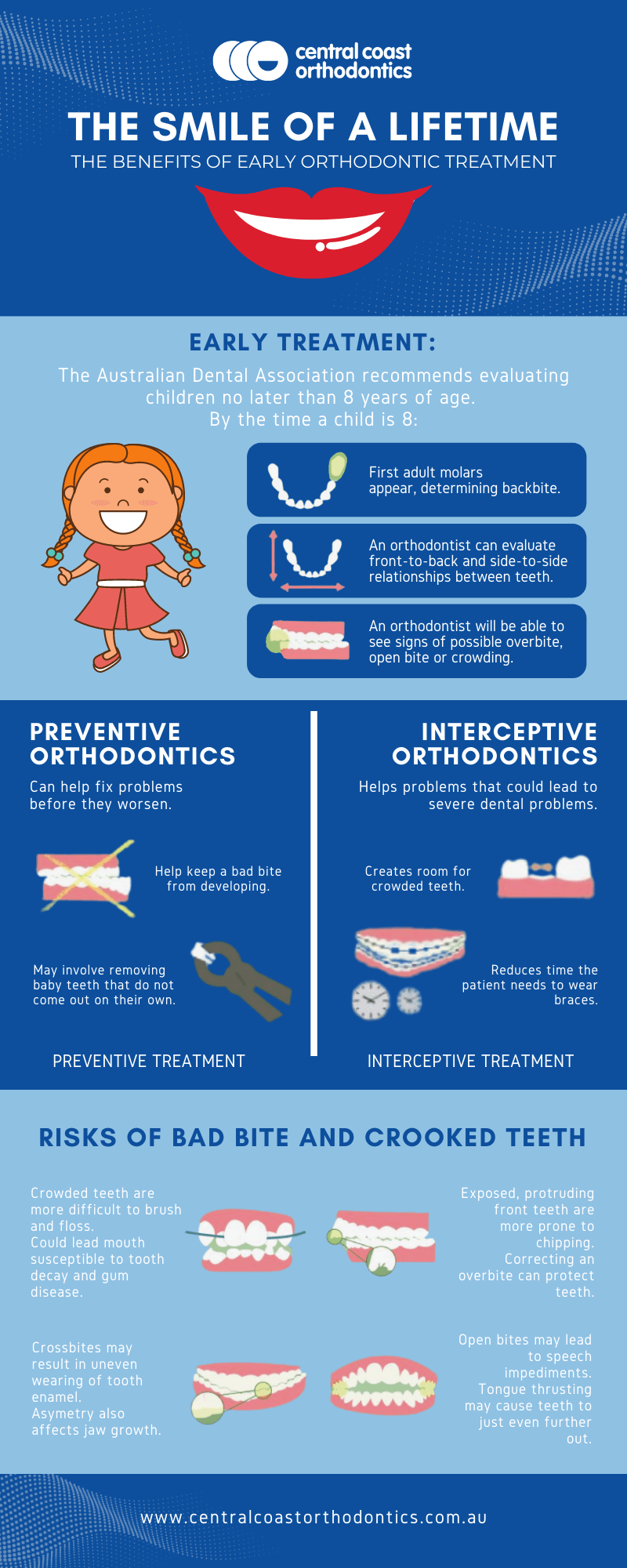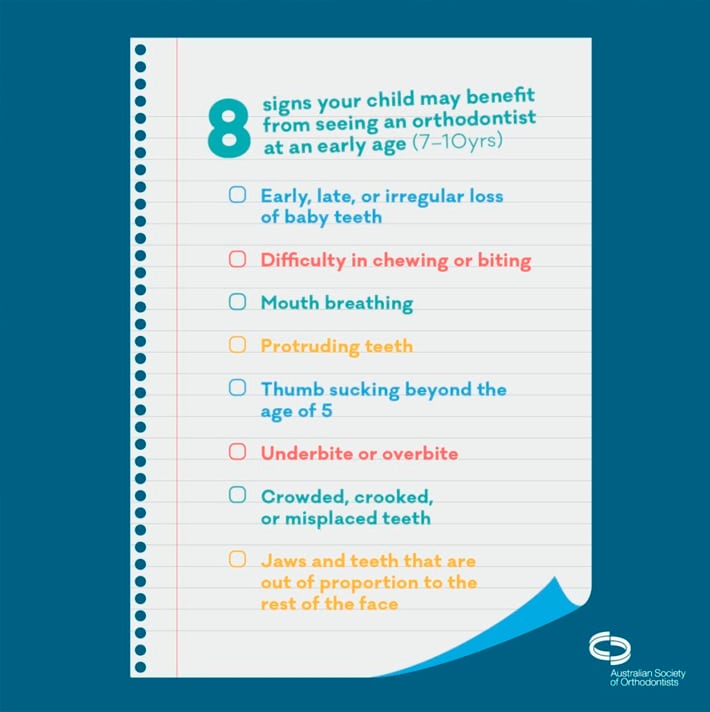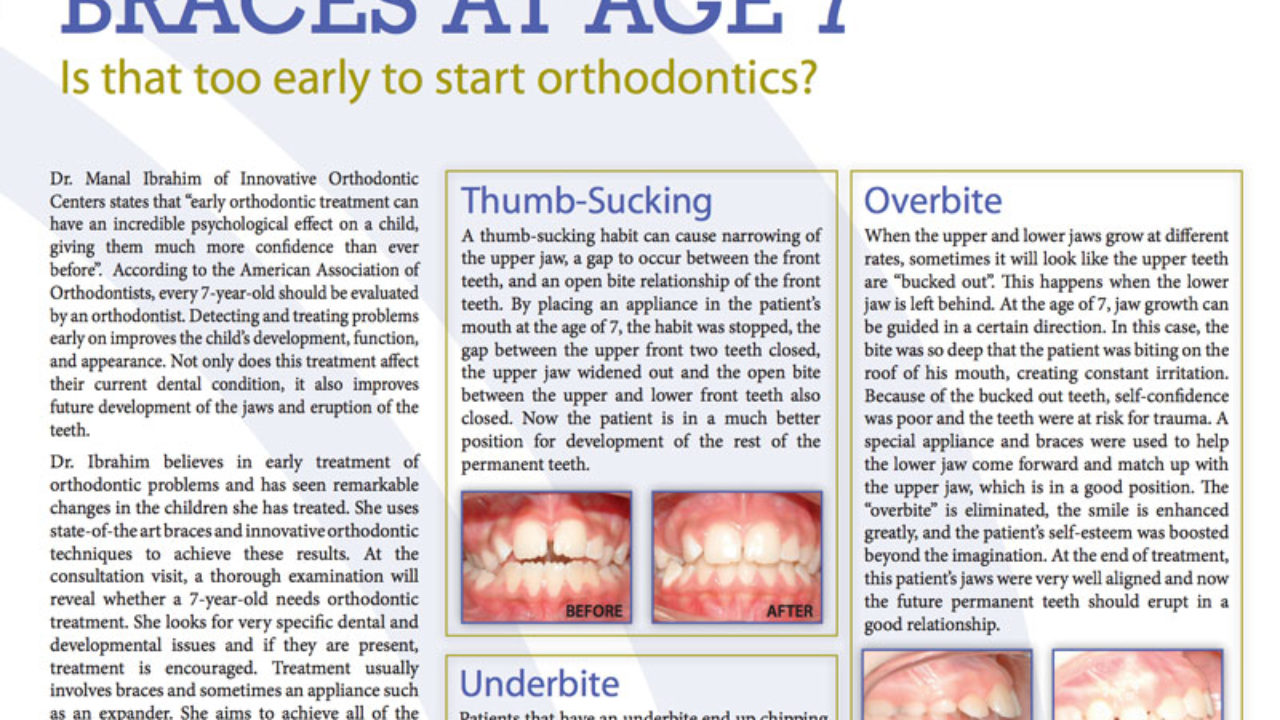Are you considering orthodontic treatment for yourself or your child? If so, you may be interested in learning about the benefits of early orthodontic intervention. Early evaluation and intervention can play a crucial role in preventing more severe dental problems in the future. By addressing orthodontic issues at an early age, such as overcrowding, overbites, underbites, and gaps, you can help to ensure proper oral development and alignment. In this article, we will explore the advantages of early orthodontic intervention for children, highlighting its importance for their oral health. By understanding the benefits of early intervention, you can make informed decisions about your orthodontic treatment and set you or your child up for a lifetime of healthy and beautiful smiles.

This image is property of www.freshorthodontics.com.
Your Guide to Choosing the Right Orthodontic Treatment
When it comes to orthodontic treatment, there are several options available to meet your specific needs and preferences. The three most common treatment options are braces, Invisalign, and lingual braces.
Braces
Braces are made up of brackets, wires, and bands that work together to apply gentle pressure to the teeth, gradually shifting them into the desired position. They are a popular choice for correcting a wide range of orthodontic issues, including overcrowding, crooked teeth, overbites, and underbites.
Invisalign
Invisalign is a more discreet alternative to traditional braces. It utilizes a series of clear, removable aligners that are custom-made to fit your teeth. These aligners gradually move your teeth into the desired position without the need for visible wires or brackets. Invisalign is a great option for those who want to straighten their teeth without drawing attention to their orthodontic treatment.
Lingual Braces
Lingual braces are similar to traditional braces in terms of their structure and function. The key difference is that the brackets and wires are placed on the backside of the teeth, making them virtually invisible from the front. Lingual braces are ideal for individuals who wish to straighten their teeth discreetly without the use of aligners.
Each orthodontic treatment option has its own unique pros and cons. Braces are highly effective and can address even the most complex orthodontic issues. Invisalign offers comfort, convenience, and a nearly invisible treatment option. Lingual braces provide the utmost discretion while still providing effective teeth straightening.
To make an informed decision, it’s important to consult with an orthodontist who can assess your specific case and recommend the best treatment option for you. They will take into consideration your orthodontic needs, lifestyle, and personal preferences.
Common Orthodontic Issues and Their Solutions
Orthodontics can effectively address a variety of common dental issues, improving both the appearance and functionality of your teeth. Some of the most common orthodontic issues include overcrowding, overbites, underbites, and gaps.
Overcrowding
Overcrowding occurs when there is insufficient space in the jaw for all the teeth to properly align. This can lead to crooked teeth, discomfort, and difficulty with oral hygiene. Orthodontic treatment can create space and align the teeth to improve both aesthetics and function.
Overbites
An overbite is characterized by the upper front teeth overlapping excessively with the lower front teeth. This can result in issues with biting, chewing, and even speaking. Orthodontic treatment can correct the alignment of the teeth and jaws, bringing the upper and lower teeth into an ideal position.
Underbites
Underbites occur when the lower jaw extends forward, causing the lower front teeth to overlap the upper front teeth. This can affect both appearance and oral function. Orthodontic treatment can help shift the teeth and jaw into the proper position for improved aesthetics and function.
Gaps
Gaps between teeth, also known as spacing issues, can occur due to various reasons, such as missing teeth or abnormal growth of the jawbone. Orthodontic treatment can help close these gaps, improving the overall alignment and appearance of the smile.
Orthodontic treatment plans are tailored to each individual’s unique needs. During your orthodontic evaluation, your orthodontist will assess your specific issues and recommend a treatment plan that will effectively address your concerns and goals.
The Benefits of Early Orthodontic Intervention for Children
Early orthodontic intervention, also known as interceptive orthodontics, refers to addressing orthodontic issues in children before their permanent teeth have fully erupted. This proactive approach can provide numerous benefits for children’s oral health.
Importance of Early Orthodontic Evaluation
Early orthodontic evaluation is crucial because it allows orthodontists to detect potential issues and develop a treatment plan at an optimal time. By evaluating a child’s dental development, orthodontists can identify problems such as jaw misalignment, crowding, and bite issues. Early detection allows for early intervention, which may prevent more severe problems from developing later on.
Prevention of More Severe Problems
Addressing orthodontic issues early on can help prevent more complex and severe problems in the future. By guiding the growth and development of the jaw and teeth, interceptive orthodontics can help create sufficient space for permanent teeth, reduce the chance of extraction, correct jaw irregularities, and facilitate proper eruption of teeth.
Early orthodontic intervention can also help improve oral function, speech development, and prevent the need for extensive orthodontic treatment in the future. It gives children the advantage of starting treatment while their jaws are still growing and more receptive to orthodontic adjustments.
Parents should consult with an orthodontist by age 7 to evaluate their child’s orthodontic needs. Even if treatment is not immediately necessary, regular check-ups can ensure optimal oral health and catch any potential issues early on.
Adult Orthodontics: It’s Never Too Late for a Straight Smile
Orthodontic treatment is often associated with children and teenagers, but it’s never too late for adults to consider achieving a straighter and more beautiful smile. There are several options available specifically designed for adult orthodontics.
Misconceptions about Adult Orthodontics
One common misconception is that orthodontic treatment is only effective during childhood and adolescence when the jaw is still growing. While it’s true that early treatment provides the advantage of a growing jaw, it doesn’t mean adults cannot achieve successful orthodontic outcomes.
Orthodontic treatment for adults may take longer compared to children and teenagers, but advancements in orthodontic technology and techniques have made it possible for adults to achieve the same transformative results. It’s important for adults to understand that investing in their smile can have a positive impact on their self-confidence and overall oral health.
Options for Adult Orthodontic Treatment
Adults have various orthodontic treatment options to choose from, depending on their specific needs and preferences. These options include traditional braces, ceramic braces, and Invisalign.
Traditional braces utilize metal brackets and wires to gradually shift teeth into the desired position. Ceramic braces, on the other hand, use tooth-colored brackets that blend in with the natural teeth, offering a more discreet treatment option.
Invisalign aligners are a popular choice among adults due to their discreet and removable nature. These clear aligners are custom-made to fit snugly over the teeth, gently guiding them into the desired position. Invisalign aligners are virtually invisible, making them a convenient choice for individuals who wish to straighten their teeth without drawing attention to their orthodontic treatment.
Adults considering orthodontic treatment should consult with an experienced orthodontist who can assess their specific needs and recommend the most suitable treatment option. It’s important to remember that investing in a straighter smile can enhance not only your appearance but also your oral health and overall well-being.

This image is property of centralcoastorthodontics.com.au.
Maintaining Oral Hygiene During Orthodontic Treatment
Maintaining good oral hygiene is essential during orthodontic treatment to prevent issues such as cavities, gum disease, and decalcification of the teeth. Taking proper care of your teeth and braces ensures the success of your treatment and the health of your smile.
Tips for Keeping Teeth and Braces Clean
- Brushing: Brush your teeth at least twice a day, using a soft-bristled brush and fluoride toothpaste. Hold the brush at a 45-degree angle and brush in small, circular motions, ensuring that you clean both the teeth surfaces and the brackets and wires of your braces.
- Flossing: Flossing can be a bit trickier with braces, but it’s important to clean between the teeth and around the wires. Use a floss threader or orthodontic floss to maneuver around the brackets and wires, removing any food particles or plaque.
- Rinsing: Rinse your mouth thoroughly with water or an alcohol-free mouthwash after brushing and flossing to remove any remaining debris.
- Orthodontic Wax: If your braces are causing discomfort or irritation, apply a small amount of orthodontic wax to the bracket or wire that is irritating your mouth.
- Avoid Sticky and Hard Foods: Certain foods can damage your braces or get stuck in them, making it harder to clean your teeth. Avoid sticky candies, gum, hard chips, and crunchy snacks that can cause brackets to loosen or wires to break.
- Regular Dental Check-ups: Schedule regular dental check-ups and cleanings to ensure that your teeth and braces are in good condition. Your dentist can identify any issues and provide additional recommendations for maintaining oral hygiene.
Remember, adhering to a proper oral hygiene routine is crucial during orthodontic treatment. By brushing, flossing, and taking care of your braces, you can maintain healthy teeth and gums throughout the duration of your treatment.
Life with Braces: What to Expect and How to Adjust
Getting braces is an exciting step towards achieving a straighter smile. However, it’s important to understand that there may be an adjustment period as you adapt to life with braces. Here’s what you can expect and some tips for navigating common challenges associated with braces.
Initial Discomfort
When you first get braces, you may experience some discomfort as your teeth and mouth adjust to the new appliances. It’s normal to feel soreness or tenderness for a few days after each adjustment appointment. Over-the-counter pain relievers and a soft diet can help alleviate any discomfort during this time.
Eating Adjustments
Certain foods may pose challenges when you have braces. Sticky and hard foods can damage your braces or get stuck, making it harder to clean your teeth. It’s important to avoid these types of foods to prevent emergencies and complications. Opt for softer foods and cut up fruits and vegetables into smaller, bite-sized pieces.
Oral Care Routines
Oral care routines with braces require a few adjustments to accommodate the brackets and wires. You should continue to brush your teeth at least twice a day, but pay extra attention to cleaning the spaces between the brackets and wires. Consider using interdental brushes or a water flosser for more effective cleaning.
You may also need to spend a bit more time brushing compared to before you had braces. Thoroughly clean each tooth, making sure to brush all surfaces and around the brackets and wires. Remember to rinse thoroughly after brushing to remove any debris.
Handling Common Challenges
Braces may occasionally cause minor issues such as loose brackets, poking wires, or discomfort from adjustments. If a bracket becomes loose, contact your orthodontist immediately. Wires that poke or irritate your mouth can be gently pushed back using a clean pencil eraser or covered with orthodontic wax.
For discomfort after adjustments, consider eating softer foods, using over-the-counter pain relievers, or applying a cold pack to the outside of your mouth. Your orthodontist can provide additional recommendations for managing any challenges you may encounter during your orthodontic journey.

This image is property of orthodonticsaustralia.org.au.
Invisalign: The Clear Path to a Straighter Smile
Invisalign is an innovative orthodontic treatment option that offers a clear and discreet way to achieve a straighter smile. It utilizes a series of custom-made, removable aligners to gradually shift your teeth into the desired position. Here’s what you need to know about Invisalign.
How Invisalign Works
Invisalign treatment begins with a consultation with an orthodontist who will assess your teeth and create a personalized treatment plan. Using advanced 3D imaging technology, orthodontists design a series of clear aligners that fit snugly over your teeth. Each set of aligners is worn for about two weeks and then replaced with the next set in the series.
As you progress through the series of aligners, your teeth will gradually move into the desired position. The aligners apply controlled and gentle force to shift the teeth while being virtually invisible.
Advantages of Invisalign over Traditional Braces
Invisalign offers several advantages over traditional braces, making it a popular choice among individuals seeking a discreet orthodontic treatment option.
One of the main advantages is the near invisibility of the aligners. Invisalign aligners are made of clear, smooth plastic that is custom-made to fit your teeth perfectly. This means that when you wear the aligners, they are barely noticeable, allowing you to undergo orthodontic treatment without drawing attention to your teeth.
Additionally, Invisalign aligners are removable, which means you can take them out when eating, brushing your teeth, or attending special events. This flexibility allows for better oral hygiene and the ability to enjoy your favorite foods without any restrictions.
Invisalign treatment also typically requires fewer visits to the orthodontist compared to traditional braces. Instead of regular adjustment appointments, you will simply receive a new set of aligners to progress through at home every few weeks. This can be a convenient option for individuals with busy schedules.
It’s important to note that Invisalign may not be suitable for everyone, as more complex orthodontic cases may require alternative treatment options. Consult with an experienced orthodontist to determine if Invisalign is the right choice for you.
Smile Makeovers: The Role of Orthodontics in Enhancing Your Appearance
Orthodontic treatment goes beyond just straightening teeth; it can significantly enhance your overall appearance and boost your self-confidence. A smile makeover involving orthodontics can help you achieve the smile of your dreams. Here’s how orthodontic treatment plays a role in enhancing your appearance.
Correcting Alignment
Orthodontics can correct misaligned teeth, closing gaps, and eliminating overcrowding. By improving the alignment of your teeth, orthodontic treatment can create a more symmetrical and visually pleasing smile. Straighter teeth can also help correct certain facial asymmetries and contribute to a more harmonious appearance.
Improving Facial Profile
Orthodontic treatment can also improve your facial profile by aligning your jaw and teeth. Issues such as overbites, underbites, or crossbites can impact the balance of your facial features. By addressing these issues, orthodontics can help achieve a more balanced and attractive facial profile.
Boosting Confidence
A confident smile can have a powerful impact on self-esteem and overall confidence. Many individuals feel self-conscious about their smiles due to misaligned teeth or other orthodontic issues. By addressing these concerns through orthodontic treatment, individuals can experience a boost in self-confidence and feel more comfortable in social and professional situations.
Before-and-after success stories can serve as powerful examples of the transformative power of orthodontics. Seeing the phenomenal results achieved by others can inspire and motivate individuals to pursue orthodontic treatment for their own smile makeovers.
Orthodontic treatment is a multi-faceted solution that not only improves the appearance of your smile but also enhances your overall facial aesthetics and self-confidence. Consult with an orthodontist to discuss your smile goals and explore the treatment options available to achieve your desired results.

This image is property of www.innovativepediatricdentistry.com.
Choosing an Orthodontist: What to Look For
Choosing the right orthodontist for your treatment is a crucial decision that can greatly impact your overall experience and the success of your orthodontic journey. Here are some factors to consider when selecting an orthodontist in Reno.
Qualifications and Credentials
When researching orthodontists, it’s important to ensure they have the necessary qualifications and credentials. Look for an orthodontist who is a member of reputable professional organizations and has received proper education and training in the field of orthodontics. This can provide reassurance that you are receiving care from a knowledgeable and experienced professional.
Technology and Treatment Options
Consider the technology and treatment options offered by the orthodontist. Advancements in orthodontic technology have transformed the field, providing more efficient and comfortable treatment options. Look for an orthodontist who utilizes the latest tools and techniques to provide the best possible care. Inquire about the different treatment options they offer and whether they have experience in the specific treatment you are considering.
Patient Reviews and Testimonials
Reading patient reviews and testimonials can provide valuable insights into the orthodontist’s practice and patient satisfaction. Look for reviews that mention the orthodontist’s professionalism, expertise, and the overall experience of patients. Positive reviews can indicate a reputable orthodontist who delivers high-quality care and exceptional results.
Personalized Approach and Communication
A personalized approach and effective communication are key factors in a positive orthodontic experience. During your initial consultation, pay attention to how the orthodontist listens to your concerns, answers your questions, and explains the treatment plan. A good orthodontist should take the time to understand your goals, explain the treatment process, and keep you informed throughout your orthodontic journey.
Accessibility and Convenience
Consider the location and office hours of the orthodontist. Choose an orthodontist who is conveniently located and offers office hours that align with your schedule. This will make it easier for you to attend appointments and ensure regular check-ups are not a burden.
Selecting an orthodontist is a personal decision, so take the time to research and gather information about the orthodontists in your area. Trust your instincts and choose an orthodontist who makes you feel comfortable, confident, and well-informed.
Orthodontics and Overall Health: The Connection You Should Know
Orthodontic health and overall well-being are closely interconnected. While orthodontics primarily focuses on the alignment and aesthetics of the teeth and jaws, it can also have positive impacts on oral hygiene and other aspects of your health.
Improved Oral Hygiene
Orthodontic treatment can help improve oral hygiene by correcting misalignments that make it difficult to clean certain areas of the mouth effectively. Straighter teeth are easier to clean, reducing the risk of plaque buildup, cavities, and gum disease. Poor oral hygiene can contribute to various health issues, including cardiovascular disease, diabetes, and respiratory infections. By investing in orthodontic treatment, you are taking proactive steps towards better oral health and overall well-being.
Speech and Pronunciation
Orthodontic treatment can also improve speech and pronunciation. Misaligned teeth or jaw irregularities can cause difficulties with speech, leading to articulation problems or speech impediments. By correcting these issues through orthodontic treatment, individuals can experience improved speech clarity, confidence, and communication skills.
Reduced Teeth Grinding
Teeth grinding, also known as bruxism, can lead to dental problems and jaw pain. Misaligned teeth or an imbalanced bite can contribute to excessive grinding or clenching of the teeth. Orthodontic treatment can help align the teeth and jaws, reducing the strain and pressure on the temporomandibular joint (TMJ) and minimizing bruxism-related issues.
Psychological Well-being
Orthodontic treatment can also have significant psychological benefits. A straighter smile can enhance self-esteem and boost confidence. Feeling more confident in your smile can have a positive impact on your social interactions, personal relationships, and overall mental well-being. Orthodontic treatment allows individuals to feel proud of their smiles and express themselves with confidence.
Orthodontic health extends beyond just teeth and jaws. By investing in orthodontic treatment, you not only achieve a straighter smile but also contribute to improved oral hygiene, speech function, TMJ health, and overall psychological well-being.
In conclusion, orthodontic treatment offers various options to address dental issues and enhance your smile. Whether you are considering treatment for yourself or your child, it’s important to make an informed decision based on your unique needs, preferences, and the guidance of a qualified orthodontist. By understanding the different treatment options, the benefits of early intervention, and the importance of oral hygiene, you can embark on your orthodontic journey with confidence. Orthodontics not only improves the appearance of your smile but also positively impacts your oral health and overall well-being. So, take the first step towards your dream smile and consult with an experienced orthodontist today.
This image is property of images.squarespace-cdn.com.
